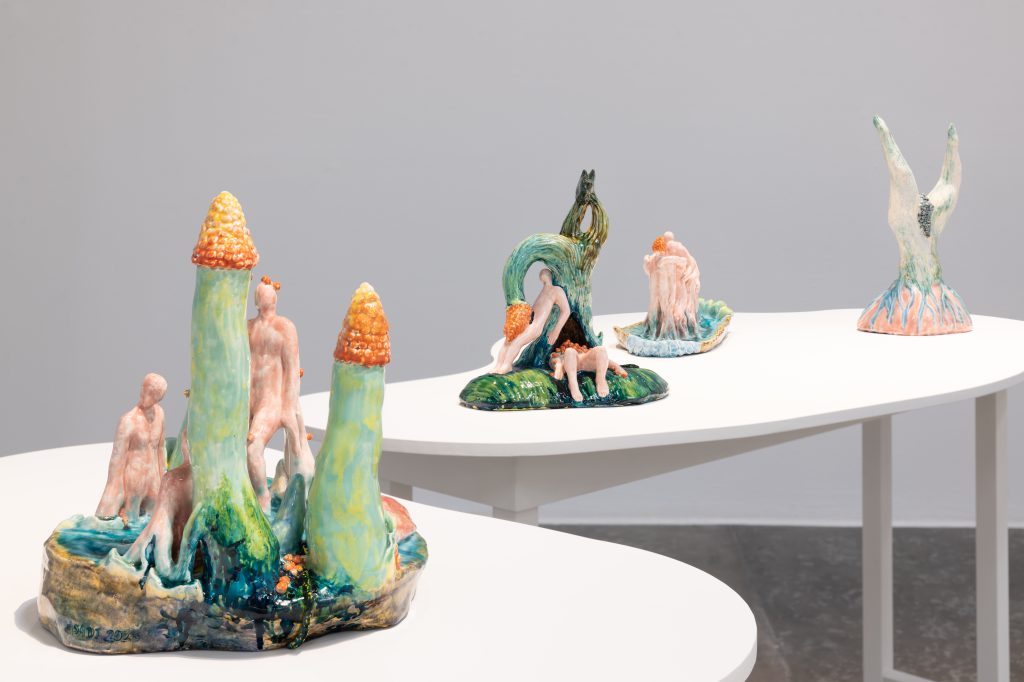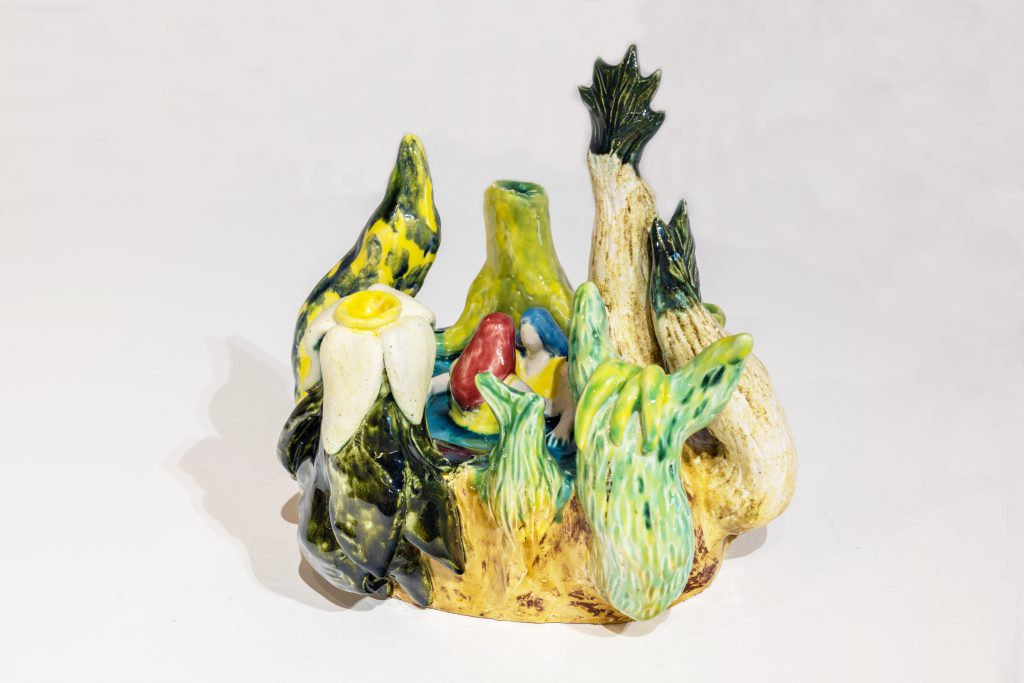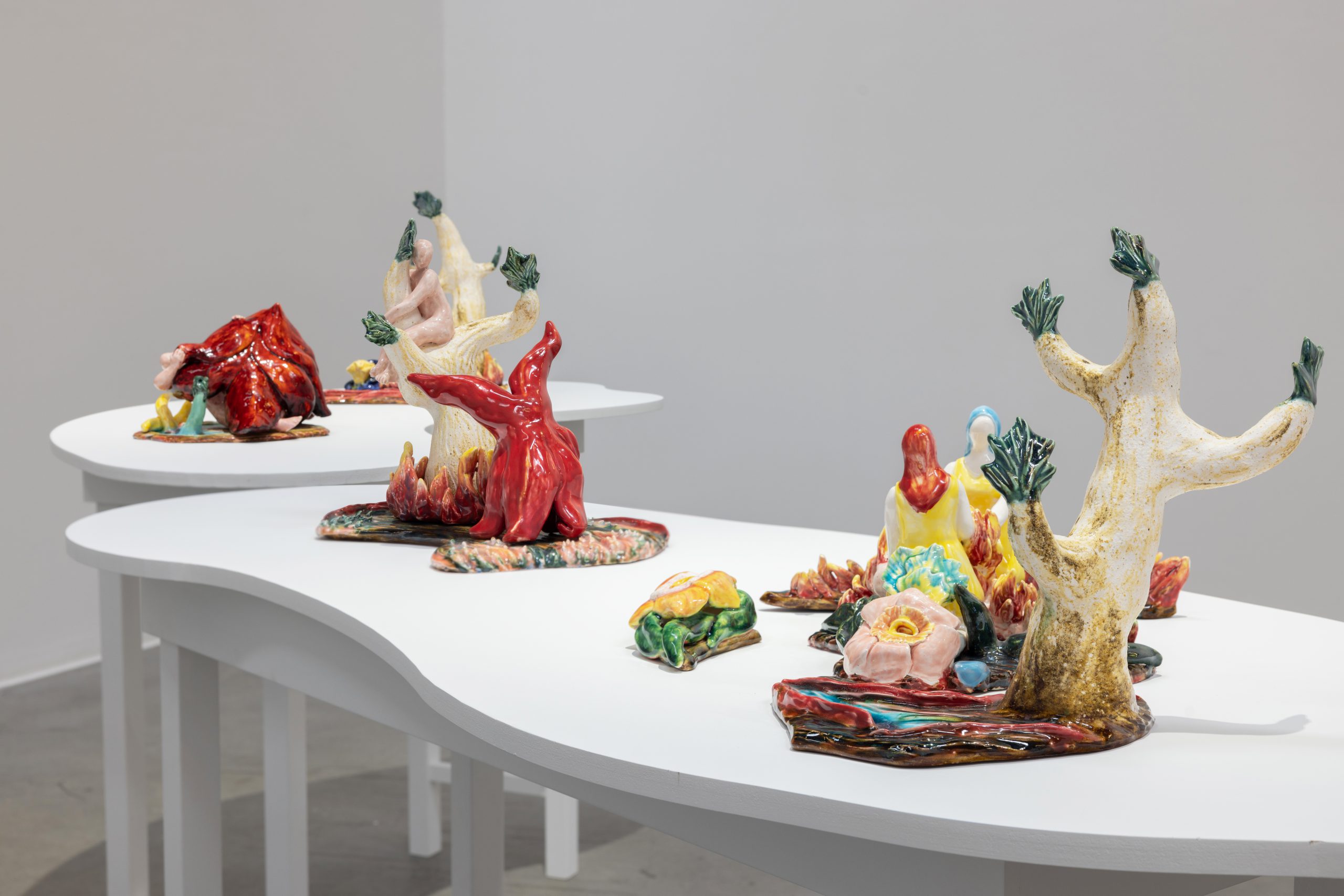Drawing influences from The Divine Comedy and US anti-racist anthems, Dorsa Asadi’s Strange Fruit at Dubai’s Green Art Gallery serves up a fiery indictment of patriarchal oppression
Their names are Elle and Belle, twin sisters birthed in a post-apocalyptic forest by a virgin mother who dies after delivery. As children they grow up roaming the forest, journeying through caves and into hidden worlds below ground and water, without true aim or intention.
Invented in 2019 by artist Dorsa Asadi, blue-haired Elle and red-headed Belle are recurring characters in her oeuvre and the protagonists in her most recent solo show Strange Fruit at Green Art Gallery, Dubai. This time, Asadi uses ceramic sculptures to depict a narrative based on Dante’s Divine Comedy, similarly divided into Inferno, Purgatorio and Paradiso. In the series of 22 works, Elle and Belle are not quite Dante and Virgil; instead, they are agents of justice, doling out hellish punishments to naked and faceless men. The women kneel over a supplicating man engulfed in flames in Bending Sinnerman offering his burning flesh to Elle and Belle (2022), his outstretched limbs suggesting torment while the siblings’ arms seem to bear the fires painlessly.
Nationwide unrest in Asadi’s native Iran during the autumn of 2022 is the instigator for Strange Fruit. Security forces killed and injured scores of protestors speaking up for women’s rights following the death of Mahsa Amini and the rape of a teenage girl. The bloodiness of these months is expressed in the wounded reds and fiery oranges of Asadi’s Inferno, where ceramic tableaux present “sinnermen” in states of fear and suffering. The pieces are clustered together according to their chapters, laid out on white tables in the gallery. The theme of protest runs throughout the titles: Strange Fruit, a song recorded by Billie Holiday, decries the lynching of Black people in the United States, and I Wish I Knew How It Would Feel to Be Free (Asadi 2023), popularised by Nina Simone, was used an anthem by the 1960s civil rights movement. “These songs were the only way things that helped me survive that terrifying autumn,” Asadi says. “These women’s voices gave me strength and kept telling me that the struggling might never end, but we have to keep going.”

Image courtesy of the artist and Green Art Gallery, Dubai
Asadi’s citation of the Divine Comedy also offers interesting ways of reading the artist’s series. Dante dedicated years of his life to writing the poem, completing it close to his death in 1321 and conceiving of it after his exile from Florence in 1301. His masterpiece is laden with references that are all at once personal, political, and spiritual – the agony of exile and the condemnation of the authorities that imposed it, a grappling with the power of the Catholic church, the question of the afterlife. The poem is as much an exploration of faith and religion as it is socio-political commentary on corruption in Florentine politics and the complicity of the Catholic church. Parallels can be made for the artist, who was born and is based in Iran, where state and clerical authorities work in concert to exert control over the population, especially women, in the name of religion.
By writing the Divine Comedy, Dante sought to understand divine justice and the redemption of sinners. The arc of Strange Fruit also bends towards this concept. By calling her characters “sinnermen”, a reference to another song popularised by Simone, this time a spiritual tune about judgment day, Asadi is seeking a balancing of the scales. Can the crimes of patriarchy be cleansed? Who can truly administer God’s orders on Earth? Is it masculine authority, individuals who wield power for their own interests?
As the show moves towards purgatory, the fires are cooled and reds become muted browns. In Elle and Belle purify the Sinnermen with their blood and tears (2023), the sisters stand over the men now covered in leech-like forms that presumably draw out evil. Here, the feminine gives from itself to bring salvation. Have Elle and Belle been enacting the commands of the divine, or have they simply taken matters into their own hands?

Image courtesy of the artist and Green Art Gallery, Dubai
Motifs of flora, frequent in the artist’s works, appear throughout the series, including narcissus flowers and plane trees or chenar, which are common in Iran. The story may have been taking place in Elle and Belle’s forest all along, a land the sisters know inside and out. Upon reaching Paradiso, the settings are now bathed in pastels of vegetation and cerulean pools. At this point, the sisters stand apart from the men, nestled and content in their own haven of greenery in Elle and Belle bathing in the pools of Paradiso (2023). Their work is done as the male figures have become “Sugarmen” and eat “heavenly fruit”. Plant life exists beyond backdrop; the men are becoming botanical as their heads mutate to budding fruits in Take me to the river (2023) and blooms cling to their bodies in Heavenly gathering (2023)and Blooming and resting Sugarmen (2023). To become divine, they have to become less human, morphing instead into nature.
Asadi’s Strange Fruit may initially give the impression of a neatly closed narrative, but hell and heaven are circular – souls spiral in and out for eternity. While justice can reach its satisfying conclusion in fiction and art, the material world tells a different story. The work is perhaps both the embodiment of revenge fantasy and yearning for righteousness. In the here and now, justice can exist, but only in imagination.
Strange Fruit runs until 29 July



